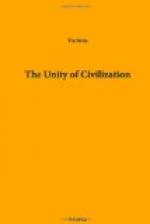It was not only by the regulation of trade and commerce that the Church sought to penetrate the life of the towns. The friars made their homes in the towns in the thirteenth century; and the activity of the friars—Franciscan and Dominican, Austin and Carmelite—enabled the Church to exercise an influence on municipal life no less far-reaching than that which she sought to exert on the feudal classes. Towns became trustees of property for the use of the mendicant orders; and the orders of Tertiaries, which flourished among them, enabled the townsfolk to attach themselves to religious societies without quitting the pursuits of lay life. A mediaeval town—with its trade and commerce regulated, however imperfectly, by Christian principle; with its town council acting as trustee for religious orders; and with its members attached as Tertiaries to those orders—might be regarded as something of a type of Christian society; and St. Thomas, partly under the influence of these conditions, if partly also under the influence of the Aristotelian philosophy of the [Greek: polis], is led to find in the life of the town the closest approach to the ethics of Christianity.
The control of learning and education by the Church is the most peculiar and essential aspect of her activity. The control of war and peace was a matter of guiding the estate of the baronage; the control of trade and commerce was a way of directing the estate of the commons; but the control of learning and education was nothing more nor less than the Church’s guidance of herself and her direction of her own estate. Studium may be distinguished from sacerdotium by mediaeval writers; but the students of a mediaeval university are all ‘clergy’, and the curricula of mediaeval universities are essentially clerical. All knowledge, it is true, falls within their scope; but every branch of knowledge, from dialectic to astronomy, is studied from the same angle, and for the same object—ad maiorem Dei gloriam. Here, as elsewhere, the penetrating and assimilative genius of the Church moulded and informed a matter which was not, in its nature, easily receptive of a clerical impression. The whole accumulated store of the lay learning of the ages—geometry, astronomy, and natural science; grammar and rhetoric; logic and metaphysics—this was the matter to be moulded and the stuff to be permeated; and on this stuff St. Thomas wrought the greatest miracle of genuine alchemy which is anywhere to be found in the annals of learning.
The learning which the Church had to transform was essentially the learning of the Hellenic world. Created by the centuries of nimble and inventive thought which lie between the time of Thales and that of Hipparchus, this learning had been systematized into a corpus scientiae during that age of Greek scholasticism which generally goes by the name of Hellenistic. In its systematized Hellenistic form, it had been received by the Roman world, and had become the culture




